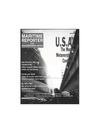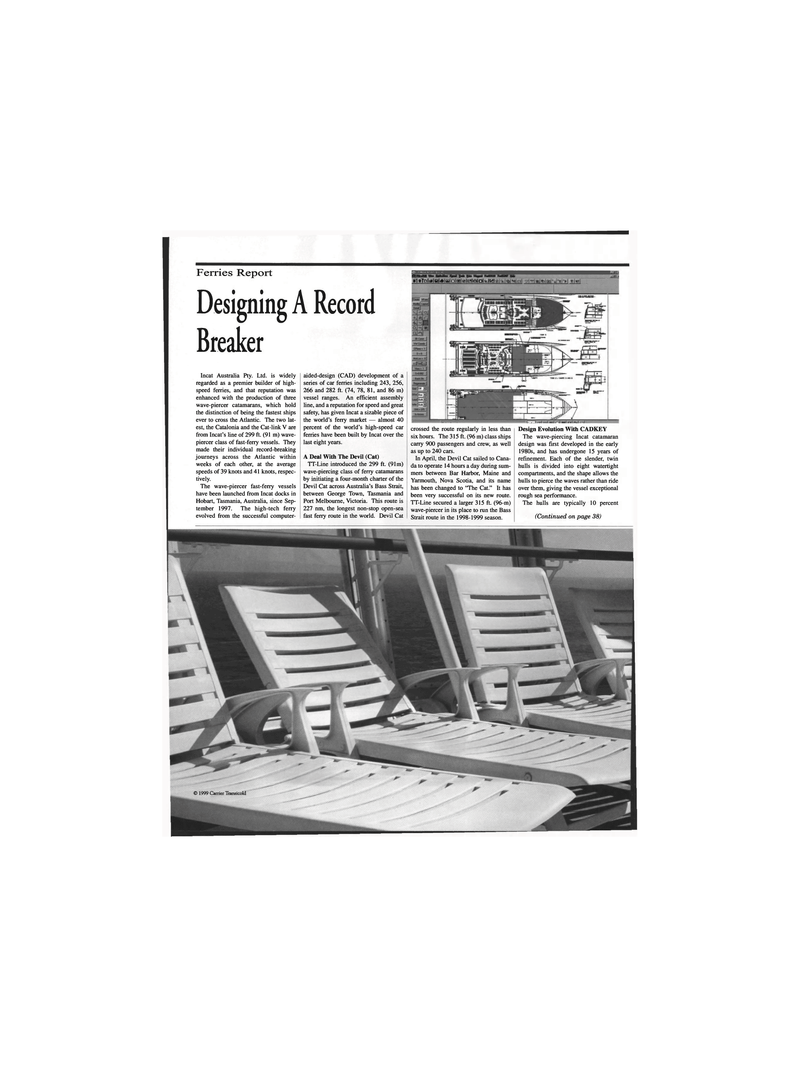
Page 34: of Maritime Reporter Magazine (August 1999)
Read this page in Pdf, Flash or Html5 edition of August 1999 Maritime Reporter Magazine
Ferries Report
Designing A Record
Breaker
Incat Australia Pty. Ltd. is widely regarded as a premier builder of high- speed ferries, and that reputation was enhanced with the production of three wave-piercer catamarans, which hold the distinction of being the fastest ships ever to cross the Atlantic. The two lat- est, the Catalonia and the Cat-link V are from Incat's line of 299 ft. (91 m) wave- piercer class of fast-ferry vessels. They made their individual record-breaking journeys across the Atlantic within weeks of each other, at the average speeds of 39 knots and 41 knots, respec- tively.
The wave-piercer fast-ferry vessels have been launched from Incat docks in
Hobart, Tasmania, Australia, since Sep- tember 1997. The high-tech ferry evolved from the successful computer- aided-design (CAD) development of a series of car ferries including 243, 256, 266 and 282 ft. (74, 78, 81, and 86 m) vessel ranges. An efficient assembly line, and a reputation for speed and great safety, has given Incat a sizable piece of the world's ferry market — almost 40 percent of the world's high-speed car ferries have been built by Incat over the last eight years.
A Deal With The Devil (Cat)
TT-Line introduced the 299 ft. (91m) wave-piercing class of ferry catamarans by initiating a four-month charter of the
Devil Cat across Australia's Bass Strait, between George Town, Tasmania and
Port Melbourne, Victoria. This route is 227 nm, the longest non-stop open-sea fast ferry route in the world. Devil Cat crossed the route regularly in less than six hours. The 315 ft. (96 m) class ships carry 900 passengers and crew, as well as up to 240 cars.
In April, the Devil Cat sailed to Cana- da to operate 14 hours a day during sum- mers between Bar Harbor, Maine and
Yarmouth, Nova Scotia, and its name has been changed to "The Cat." It has been very successful on its new route.
TT-Line secured a larger 315 ft. (96-m) wave-piercer in its place to run the Bass
Strait route in the 1998-1999 season.
Design Evolution With CADKEY
The wave-piercing Incat catamaran design was first developed in the early 1980s, and has undergone 15 years of refinement. Each of the slender, twin hulls is divided into eight watertight compartments, and the shape allows the hulls to pierce the waves rather than ride over them, giving the vessel exceptional rough sea performance.
The hulls are typically 10 percent (Continued on page 38) tgigteisEdl View Appicabom Fgmat look &ala Vjegport FastSQUD FastSURF Hefr • |VFPl*M«|n|D|ia|ielHMo|^ © 1999 Carrier Transicold

 33
33

 35
35
